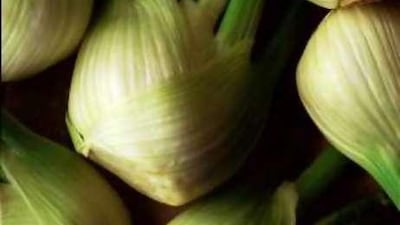Hands up who's heard of fennel. Good, that's almost all of you. Now, how many of you actually know how to use it? Anybody? Hmm? Detention for the lot of you. Fennel may have enjoyed a renaissance on restaurant menus over the past decade, but relatively few people would know what to do with it if it started sprouting spontaneously in their airing cupboards. Perhaps that's because it's difficult to pinpoint exactly what fennel is. Some use its leaves as an herb, while others exploit its seeds like a spice. And then there are those who treat its bulblike stem as a vegetable.
Technically, it's an umbelliferous herb - an aromatic plant that's related to cumin, coriander, parsley and celery. But what's more obvious is its likeness to star anise in terms of flavour and fragrance. The distinctive liquorice-style qualities of fennel originate from an aromatic compound called anethole, which is also present in anise and star anise. But while these spices can often be quite pungent, fennel is known to be far milder and therefore much more palatable for most people.
The presence of anethole in fennel gives it aromatic and carminative properties that make it useful in medicine, in fact, it was used to cure ailments in ancient Greece. Since then, fennel has been used in a variety of cultures to treat everything from upset stomachs to cholera, poor eyesight and even snakebites. It is also believed to be effective in warding off fleas in kennels and stables. It's hardly surprising that such a useful herb had a high profile in many ancient cultures. In Greek mythology, the Titan Prometheus stole fire from the gods using the stalk of a giant fennel plant. The Anglo-Saxons, on the other hand, believed that fennel featured alongside such exotic ingredients as crab apple, mugwort and stinging nettles as one of the nine sacred herbs used to keep diseases and evil spirits at bay. Since fennel has played such a big role in our past, it's probably time it played a bigger part in our present.
So, how can you get the most out of fennel? Let's start with the seeds. You've probably seen bowls of them offered at the end of the meal in Indian restaurants, to aid digestion and freshen the breath.
But fennel seeds can also be immersed in boiling water to make a piquant and refreshing tea. The leaves of fennel can be chopped and added to white fish dishes, especially in Italian cuisine where the Florence fennel is often called upon to lend an aromatic quality to recipes. Italians often use the firm white bulb of the Florence fennel as a root vegetable, grilling, roasting, simmering or sautéing it and using it in salads, perhaps with white beans and Parmesan cheese. There's so much more to discover. In fact, the more you begin to learn about fennel, the more shocked you'll be about how little you used to know.
@email:jbrennan@thenational.ae

